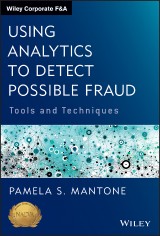Details

Using Analytics to Detect Possible Fraud
Tools and TechniquesWiley Corporate F&A 1. Aufl.
|
73,99 € |
|
| Verlag: | Wiley |
| Format: | EPUB |
| Veröffentl.: | 16.07.2013 |
| ISBN/EAN: | 9781118715987 |
| Sprache: | englisch |
| Anzahl Seiten: | 368 |
DRM-geschütztes eBook, Sie benötigen z.B. Adobe Digital Editions und eine Adobe ID zum Lesen.
Beschreibungen
<b>Detailed tools and techniques for developing efficiency and effectiveness in forensic accounting</b> <p><i>Using Analytics to Detect Possible Fraud: Tools and Techniques</i> is a practical overview of the first stage of forensic accounting, providing a common source of analytical techniques used for both efficiency and effectiveness in forensic accounting investigations. The book is written clearly so that those who do not have advanced mathematical skills will be able to understand the analytical tests and use the tests in a forensic accounting setting. It also includes case studies and visual techniques providing practical application of the analytical tests discussed.</p> <ul> <li>Shows how to develop both efficiency and effectiveness in forensic accounting</li> <li>Provides information in such a way that non-practitioners can easily understand</li> <li>Written in plain language: advanced mathematical skills are not required</li> <li>Features actual case studies using analytical tests</li> </ul> <p>Essential reading for every investor who wants to prevent financial fraud, <i>Using Analytics to Detect Possible Fraud</i> allows practitioners to focus on areas that require further investigative techniques and to unearth deceptive financial reporting before it's too late.</p>
<p>Preface xi</p> <p>Acknowledgments xv</p> <p><b>Chapter 1: Overview of the Companies 1</b></p> <p>The Four Companies 2</p> <p>Company 1 2</p> <p>Company 2 5</p> <p>Company 3 8</p> <p>Company 4 10</p> <p>Summary 16</p> <p><b>Chapter 2: The “Norm” and the “Forensic” Preliminary Analytics: Basics Everyone Should Know 19</b></p> <p>Liquidity Ratios 20</p> <p>Working Capital 21</p> <p>Working Capital Index 21</p> <p>Working Capital Turnover 22</p> <p>Current Ratio 22</p> <p>Case Studies: Liquidity Ratios 22</p> <p>Profitability Ratios 25</p> <p>Gross Profit 26</p> <p>Gross Profit Margin 26</p> <p>Stock Sales 26</p> <p>Return on Equity 27</p> <p>Case Studies: Profitability Ratios 27</p> <p>Company 1 31</p> <p>Horizontal Analysis 36</p> <p>Company 1 36</p> <p>Company 2 43</p> <p>Company 3 50</p> <p>Company 4 61</p> <p>Vertical Analysis 66</p> <p>Company 1 66</p> <p>Company 2 70</p> <p>Company 3 73</p> <p>Company 4 79</p> <p>Summary 79</p> <p><b>Chapter 3: The Importance of Cash Flows and Cash Flow Statements 83</b></p> <p>Cash Flows and Net Income 85</p> <p>Company 1 87</p> <p>Company 2 89</p> <p>Company 3 92</p> <p>Company 4 97</p> <p>Other Cash Flow Techniques 100</p> <p>Company 1 101</p> <p>Company 2 104</p> <p>Company 3 107</p> <p>Company 4 114</p> <p>Summary 117</p> <p><b>Chapter 4: The Beneish M-Score Model 119</b></p> <p>Company 1 124</p> <p>Company 2 133</p> <p>Company 3 143</p> <p>Indices of the Primary Government 145</p> <p>Indices of the Governmental Funds 151</p> <p>Company 4 158</p> <p>Summary 166</p> <p>Notes 170</p> <p><b>Chapter 5: The Accruals 171</b></p> <p>Dechow–Dichev Accrual Quality 173</p> <p>The Four Companies: Dechow–Dichev Model 175</p> <p>Sloan’s Accruals 184</p> <p>The Four Companies: Sloan’s Model 185</p> <p>Jones Nondiscretionary Accruals 191</p> <p>The Four Companies: Jones Model 192</p> <p>Summary 196</p> <p>Notes 198</p> <p><b>Chapter 6: Analysis Techniques Using Historical Financial Statements and Other Company Information 199</b></p> <p>The Piotroski F-Score Model 200</p> <p>Company 1 203</p> <p>Company 2 205</p> <p>Company 3 207</p> <p>Company 4 212</p> <p>Lev–Thiagarajan’s 12 Signals 215</p> <p>Company 1 220</p> <p>Company 2 222</p> <p>Company 3 225</p> <p>Company 4 230</p> <p>Summary 233</p> <p>Notes 235</p> <p><b>Chapter 7: Benford's Law, and Yes—Even Statistics 237</b></p> <p>Benford’s Law 239</p> <p>Company 1 243</p> <p>Company 2 249</p> <p>Company 3 255</p> <p>Company 4 267</p> <p>Simple Statistics 272</p> <p>Company 1 277</p> <p>Company 2 281</p> <p>Company 3 284</p> <p>Company 4 289</p> <p>Summary 290</p> <p>Note 292</p> <p><b>Chapter 8: Grading the Four Companies 293</b></p> <p>Company 1 294</p> <p>Company 2 302</p> <p>Company 3 310</p> <p>Company 4 320</p> <p>Summary 326</p> <p>Bibliography 329</p> <p>About the Author 331</p> <p>Index 333</p>
<p><b>PAMELA S. MANTONE, CPA, CFF, CITP, CGMA, CFE, FCPA,</b> is a Senior Assurance Manager at Joseph Decosimo & Company, PLLC, practicing in the areas of audit and attestation with a focus on forensic accounting, fraud examination and audits of financial institutions, nonprofit organizations, publicly traded companies and governments. She provides forensic accounting services, with an emphasis on embezzlement and fraudulent financial information for multiple organizations, as well as consulting services regarding the implementation of fraud prevention and fraud protection internal control systems.
<p><b>USING ANALYTICS TO DETECT POSSIBLE FRAUD</b><br> Tools and Techniques <p>Forensic accounting is the hot new field in accounting, involving essential investigative techniques that uncover accounting fraud and enable practitioners to be effective in covering the needs of the engagement. <p><i>Using Analytics to Detect Possible Fraud: Tools and Techniques</i> presents a plain-English guide to forensic accounting, providing analytical tools and techniques that allow professionals analyzing financial statements to zero in on anomalies. Certified Fraud Examiner Pamela Mantone introduces a variety of techniques starting from the very basic, simple analytics to more advanced analytical tools that equip forensic accountants, forensic investigators, and fraud investigators to develop further investigative work. <p>Featuring case studies throughout from four companies, illustrating the application of tools included in the book, <i>Using Analytics to Detect Possible Fraud</i> demonstrates how to interpret the results of the testing in each case study, with techniques including: <ul> <li>Liquidity ratios</li> <li>Profitability ratios</li> <li>Horizontal analysis</li> <li>Vertical analysis</li> <li>Cash realized from operations</li> <li>Analyzing cash realized from operations to net income from operations</li> <li>The Beneish M-Score Model</li> <li>Dechow-Dichev Accrual Quality</li> <li>Sloan's Accruals</li> <li>Jones Non-discretionary Accruals</li> <li>The Piotroski F-Score Model</li> <li>Lev-Thiagarajan's 12 Signals</li> <li>Benford's Law</li> <li>Z-Score Analysis</li> <li>Correlation</li> <li>Regression Analysis</li> </ul> <p>Essential reading for every financial investigator, <i>Using Analytics to Detect Possible Fraud</i> allows practitioners to focus on areas that require further investigative techniques and to unearth deceptive financial reporting.
Diese Produkte könnten Sie auch interessieren:

Fraud Analytics Using Descriptive, Predictive, and Social Network Techniques

von: Bart Baesens, Veronique Van Vlasselaer, Wouter Verbeke

33,99 €
















